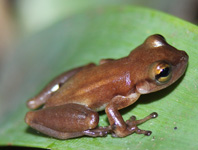Abstract
Califorctenus gen. nov. (Araneae: Ctenidae) a new genus and a new species (Califorctenus cacachilensis sp. nov.) from the Baja California Peninsula in Mexico are described and illustrated. Califorctenus gen. nov. can be diagnosed by the morphology of the male palp, with embolus cylindrical and elongated, locking lobes of embolus positioned retrolaterally and the cup-shaped and elongated median apophysis.
References
Alayón-Garcia, G. (2002) Dos especies nuevas de Ctenus (Araneae:Ctenidae) de Quintana Roo, México. Soledon, 2, 11–16.
Alvarez-Padilla, F. & Hormiga, G. (2008) A protocol for digesting internal soft tissues and mounting spiders for scanning electron microscope. Journal of Arachnology, 35, 538–542.
https://doi.org/10.1636/Sh06-55.1Barth, F.G. & Cordes, D. (1998) Cupiennius remedius a new species (Araneae, Ctenidae) and key for the genus. Journal of Arachnology, 26, 133–141.
Bremer, K. (1994) Branch support and tree stability. Cladistics, 10, 295–304.
https://doi.org/10.1111/j.1096-0031.1994.tb00179.xDupérré, N. (2015) Description of a new genus and thirteen new species of Ctenidae (Araneae, Ctenidae) from the Chocó region of Ecuador. Zootaxa, 4028 (4), 451–484.
https://doi.org/10.11646/zootaxa.4028.4.1Fitch, W.M. (1971) Toward defining the course of evolution: minimal change for a specific tree topology. Systematic Zoology, 20, 406–416.
https://doi.org/10.2307/2412116Gertsch, W.J. (1971) A report on some Mexican cave spiders. Association Mexican Caves studies Bulletin, 4, 47–111.
Goloboff, P.A., Farris J.S., Källersj M., Oxelman B., Ramírez, M.J. & Szumik C.A. (2003) Improvements to resampling measures of group support. Cladistics, 19, 324–332.
https://doi.org/10.1111/j.1096-0031.2003.tb00376.xGoloboff, P.A., Farris, J.S. & Nixon, K. (2008) TNT, a free program for phylogenetic analysis. Version 1.1. Program and documentation. Available from : http://www.zmuc.dk/public/phylogeny/tnt/ (accessed 4 October 2016)
Griswold, C.E., Ramírez, M.J., Coddington, J.A. & Platnick, N.L. (2005) Atlas of phylogenetic data for entelegyne spiders (Araneae:Araneomorphae: Entelegynae) with comments of their phylogeny. Proceedings of the California Academy of Sciences of the United States of America, 56, 1–324.
Höfer, H., Brescovit, A.D & Gasnier, T. (1994) The wandering spiders of the genus Ctenus (Ctenidae, Araneae) of Reserva Ducke, a rainforest reserve in central Amazonian. Andrias, 13, 81–98.
Jocqué, R. & Dippenaar-Schoeman, A.S. (2006) Spider Families of the World. Musée Royal del’Afrique Central, Tervuren, 336 pp.
Medina-Soriano, F.J. (2006) A new species of Cupiennius (Araneae, Ctenidae) coexisting with Cupiennius salei in a Mexican mangrove forest. The Journal of Arachnology, 34, 135–141.
https://doi.org/10.1636/H03-58.1Maddison, W.P. & Maddison, D.R. (2010) Mesquite: a modular system for evolutionary analysis. Version 2.73. Available from: http://mesquiteproject.org (accessed 4 Octobrer 2016)
Nixon, K.C. (2002) Winclada (BETA) ver. 10.00.08. Published by the author, Ithaca, NY.
Peck, W.B. (1981) The Ctenidae of Temperate Zone North American. Bulletin of the American Museum of Natural History, 170, 157–169.
Polotow, D. & Brescovit, A.D. (2008) Revision of the neotropical spider genus Gephyroctenus (Araneae: Ctenidae: Calocteninae). Revista Brasileira de Zoologia, 25, 705–715.
https://doi.org/10.1590/S0101-81752008000400016Polotow, D. & Brescovit, A.D. (2009) Revision and cladistic analysis of Isoctenus and description of a new neotropical genus (Araneae, Ctenidae, Cteninae). Zoological Journal of the Linnean Society, 155, 583–614.
https://doi.org/10.1111/j.1096-3642.2008.00452.xPolotow, D. & Brescovit, A.D. (2014) Phylogenetic analysis of the tropical wolf spider subfamily Cteninae (Arachnida, Araneae, Ctenidae). Zoological Journal of the Linnean Society, 170, 333–361.
https://doi.org/10.1111/zoj.12101Polotow, D. & Jocqué, R. (2014) The new spider genus Arctenus, an afrotropical representative of the Calocteninae (Araneae:Ctenidae). Journal of Arachnology, 42, 240–247.
https://doi.org/10.1636/0161-8202-42.3.240Polotow, D., Carmichael, A. & Griswold, C.E. (2015) Total evidence analysis of the phylogenetic relationships of Lycosoidea spiders (Araneae, Entelegynae). Invertebrate Systematics, 29, 124–163.
https://doi.org/10.1071/IS14041Silva, D.D. (2003) Higher-level relationship of the spider family Ctenidae (Araneae:Ctenoidea). Bulletin of the American Museum of Natural History, 274, 1–86.
https://doi.org/10.1206/0003-0090(2003)274<0001:HLROTS>2.0.CO;2Swofford, D.L. & Maddison, W.P. (1987) Reconstructing ancestral character states under Wagner parsimony. Mathematical Biosciences, 87, 199–229.
https://doi.org/10.1016/0025-5564(87)90074-5Ubick, D., Paquin, P., Cushing, P.E. & Roth, V. (Eds.) (2005) Spiders of North America: an identification manual. American Arachnological Society, Keene, New Hampshire, 377 pp.
World Spider Catalog (2016) World Spider Catalog Natural History Museum Bern. Version 17.0. Available from: http://www.wsc.nmbe.ch (accessed 9 March 2016)

